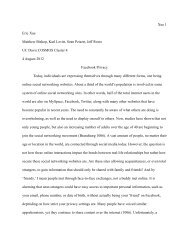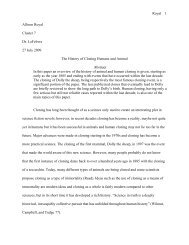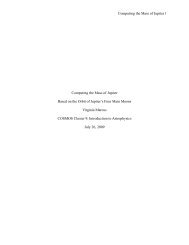You also want an ePaper? Increase the reach of your titles
YUMPU automatically turns print PDFs into web optimized ePapers that Google loves.
combine the best characteristics of the current three designs and eliminate the drawbacks,creating an earbud holder that will store earbuds in an efficient, secure, and aestheticallypleasing fashion on the back of an iPhone case.FUNCTION AND CONSTRAINTSIn order for the CaseBud to accomplish its goal, the device must:Hold earbudsReduce time of taking in and out of earbudsRetain the aesthetics and minimalistic theme of the iPhoneStay small for ease of holding and usageAttach to the back of existing cases for customizationThe design is limited by the following constraints:The width must be equal to or thinner than ⅝ inch The length must stay smaller than a standard iPhone 4/4S Speck case (3.19”)Won’t expose earbud cordsAllows user to put away earbuds in under 15 seconds3
DESIGN CONCEPTSDesign 1D1 contains a slide out drawer that will allow one to wrap their earbuds around a flatsurface and then quickly slide it back into the case compartment. Then, the cap can beclosed to keep the case flush and solid, while at the same time protecting the earbudsfrom any sort of damage. This solves the problem of earbud damage, tangled earbuds,missing earbuds, while keeping the process quick and simple to become a good habit thatanyone can stick to.4
Design 2D2 consists of foldable clips that pop out from the back of the case. Then, the earbudscan be wrapped around the clips and the clipped back down. This way, the cord is asflush as possible to the back of the case while also preventing it from coming loose. Asan added bonus, the clips can be folded down when not in use to keep the size of the caseto a minimum.5
Design 3D3 utilizes the edge of the iPhone to wrap the cords. Doing so will add minimal thicknessthe iPhone, preserving the sleek and sexy look that users look for when they purchasetheir iPhones. It ends by leading the cords through a groove in the middle of the case andlocking the earbud heads to the top of the case.6
Decision MatrixIn order to decide between the 3 designs, we used a decision matrix. Our priorities wereprimarily reliability, aesthetics, and ease of manufacturing. Therefore, those are weightedthe highest as opposed to time, testability, and cost. Our rationale for putting reliabilityfirst was because we wanted our design to protect the earbuds as well as possible fromfraying and tangling; to address all the issues presented in our problem statement. Weultimately decided on design 1 as it fit our criteria the best out of the 3.7
FABRICATION PLANCutting Stage:1. Cut out ⅝” x 2-7/16” piece of 1/16” acrylic (A)2. Cut out two ⅝” x 3-7/16” pieces of 1/16” acrylic (B)3. Cut out 2-5/16” x 2-3/4” piece of 1/16” acrylic (C)4. Cut out 2-5/16” x ¼” piece of 1/16” acrylic (D)5. Cut out 2-5/16” x 1/2” piece of 1/8” acrylic (E)6. Cut out 2-5/16” x 3-7/16” piece of 1/16” acrylic (F)7. Cut out two 2-5/16” x 1/2” piece of 1/16” acrylic (G)8. Cut out two 2-5/16” x 1/2” piece of 1/8” acrylic (H)9. Cut out one 2 -1/2” x ½” piece of ⅛” acrylic (I)10. Cut out two 3” x ¼” piece of 1/8” acrylic (J)11. Cut out one 3/8” by 1” piece of 1/8” acrylic (K)Gluing/Assembly Stage:1. Glue part G & H together x 22. Glue the two combined parts onto one end of part I3. Glue part K onto the other end of part I perpendicular in orientation4. Assemble the frame using parts A, B, and F5. Glue pieces D and E together at right angles6. Attach part C onto the frame7. Attach the combined D&E piece to part C of the frame using a hinge, leaving agap of 5/16” to close properly8. Attach part J in reference to the moving piece so that they function well as guides9
9. Use leftover acrylic as stoppers for the guides10. Attach closing mechanism (from plastic container) onto parts E and FTESTING PLANIn order for us to make sure the case works, we will have to assemble it properly, mountit on an iPhone case and place it onto an iPhone. The case will have to hold the earbudsproperly and be able to slide in and out with ease. After the attachment is mounted, wewill record the amount of time it takes to wrap to store earbuds using the caseattachments to see if it meets our design goal/constraint.BUDGETItem Number Individual Price TotalHinge 2 $3 $6Small Springs 3 $2 $6Superglue 1 $3 $3Acrylic 10 Donated $0Acrylic Glue (Cement) 1 $7 $7$2210
DISCUSSION, CONCLUSION, & RECCOMMENDATIONS:While we fabricated extensive designs and toiled for hours in preparation, theproject still encountered many unforeseen problems; some were minor while others weredisastrous. First, we designed the case to be manufactured by a 3D printer. However, theprinters became unavailable so we had to adapt our manufacturing plan to use acrylicplastic. Through our attempts at cutting the acrylic and assembling a prototype case, wediscovered that hand cutting acrylic was not accurate enough to accommodate for theclose tolerance needed to make a case that can actually hold a phone. Thus, we wereforced to simplify the design into a basic attachment to be glued or screwed onto the backof a preexistent iPhone case instead of making the whole case. The new design does nothave to deal with tolerances, which made the process of manufacturing much simpler.Nevertheless, the small pieces that had to be created before assembling the full earbudholder were still challenging to cut out using the process that we were taught. Since theonly way to cut acrylic was scoring with a blade and breaking it over a table edge, it ledto bumpy edges and chips in the plastic that had to be painstakingly filed and sandeddown. The process of manufacturing a prototype was definitely a challenge, but it giveseven more appreciation to the existence of 3D printers as rapid prototyping machines.Cutting, filing, sanding, and gluing took my partner and I over a week to accomplish,whereas a 3D printer could take a 3D CAD model and have the case printed in a matter ofhours. The 3D printer would also be more accurate and the model printed would beprecise enough to actually hold an iPhone case. Our project was ultimately meant to be3D printed, but the model that we printed is proof of concept that our design actuallyworks and effectively solves the problem laid out in the beginning of this project. Future11
improvements to our design include metal guides that would allow the holder piece toslide in and out more smoothly, and the entire scale of the device can be shrunken downto less than ½” using precision machining and manufacturing that sadly were not at ourdisposal. When the holder is manufactured as part of the case, the thickness can beminimized and the size of the case will be no larger than a backup battery case.Ultimately, the most significant design improvement to the holder is to make itcompatible with any phone case using a method of either a snap on clip or an reusableadhesive, enabling our design to become mainstream for any phone or portable device.12
APPENDIXClosing Attachment13
REFERENCEiPhone 4s Schematics14
















